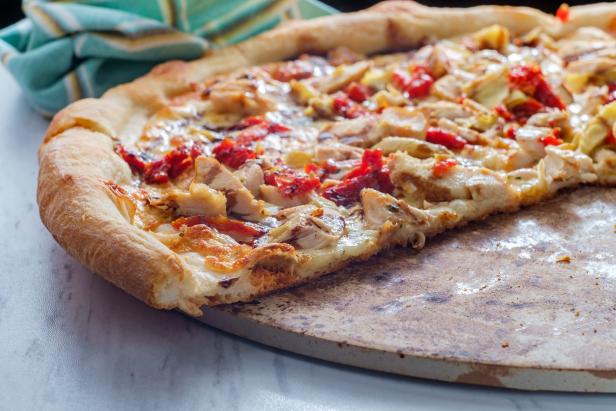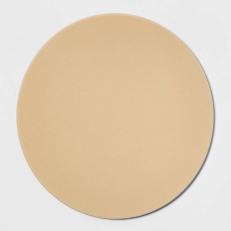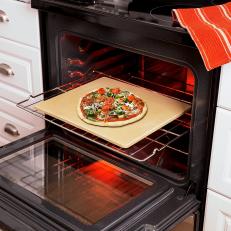How to Use a Pizza Stone in the Oven
It's a must-have tool for restaurant-style pizzas at home!

Monty Rakusen/Getty Images
By Carlos C. Olaechea for Food Network Kitchen
Using a pizza stone can completely change your homemade pizza game. So much so, in fact, that you may not need to outsource pizza again (though we won’t blame you if you do!). This simple addition to your kitchen transforms your oven to behave more like a brick oven — but what does this mean for your homemade pizza? The answer: Better crusts and shorter cook times.
Before you start using your pizza stone, though, there are a few things you should know to get the most out of this pizza lover’s essential kitchen tool. With just a little care, your stone can deliver amazingly tasty pizzas for years. Find out more on how to use a pizza stone below.
What is a pizza stone?
While a pizza stone is sturdy, heavy and heats up like a stone, it’s actually not a real stone. Pizza stones are flat pieces of unglazed clay that are usually about one inch thick and round. They are meant to fit inside a home oven, so they are usually small enough for a standard oven rack.
Pizza stones exist because most regular home ovens don’t get hot enough to properly cook certain styles of pizza. Thinner crust styles, like Neapolitan and New York pizzas, tend to suffer from the lower heat of a home oven, which is why the crust is never quite right without a stone, no matter how much you labored over making the perfect dough.
Pizza stones absorb heat easily and retain that heat for a long period of time. This mimics the effect of a pizzeria’s brick oven by raising the temperature and providing an extra-hot surface to bake the pizza. The higher heat creates a perfect pizza crust but can also cut the baking time to less than 10 minutes, meaning you can pump out pizzas like a real pizzaiolo.
How to Cook with a Pizza Stone
Cooking with a pizza stone is really simple with the right technique. Start by placing your pizza stone on the lowest rack of your cold oven. This is very important — you never want to place a cold (or room temperature) pizza stone in a hot oven as this leads to thermal shock, which can cause your pizza stone to crack or even explode.
You will want to give the pizza stone an extra 30 minutes to preheat after your oven has come to the correct temperature. Meanwhile, you need to let your pizza dough come to room temperature. Placing cold pizza dough on a hot stone can also cause it to break. When used properly, most pizzas will cook in about eight to 10 minutes with a pizza stone.
Keep in mind that the clay a pizza stone is made from is porous and can absorb flavors and odors. That said, be conscious of what flavorings you decide to put in your pizza dough if you decide to get experimental. Anchovies in your pizza crust can be tasty, but you may end up with anchovy-flavored pizzas for a very long time.
Pizza Peels
If you’ve ever considered getting a pizza stone, you probably noticed that they’re often sold with something called a pizza peel. Remember that the pizza stone stays in the oven, meaning you don’t remove them after baking like you would a baking sheet or pizza pan. As such, you need a way to easily transfer your pizza to your stone without burning yourself. This is where pizza peels come in handy, which are kind of like pizza spatulas with wide paddles with handles that help you transfer pizzas to and from the stone.
Using a Pizza Peel
To use a pizza peel with your pizza stone, first sprinkle the peel with cornmeal. This keeps the dough from sticking to the peel and helps it slide off easily from the peel to the stone. Next, roll out a 10- to 12-inch round of dough and place it on the peel. Shake the peel around a bit to see if the dough can slide around easily. If not, lift up the corners of the dough and sprinkle some more cornmeal on the peel.
Now you can add your sauce and toppings to your pizza dough. When you’re read to bake, grab onto the handle of your peel, open the oven door, and Point the tip of your peel onto the back edge of your preheated pizza stone. Pull the peel towards you while letting the pizza gently slide onto the stone.
You can use the peel to remove the cooked pizza from the oven, but it’s trickier to do that than it is to place a pizza on the stone. It’s recommended to use the peel (or a metal spatula) to slide the pizza from the stone onto your peel. You can then transfer the pizza to a plate or cutting board.
No Pizza Peel?
You don’t really need a pizza peel to use a pizza stone. You can use a large plate without a rim or a large cutting board to transfer the pizza onto the stone. However, you will need to pull out the oven rack with the stone on it to slide the pizza from the cutting board or plate onto the stone. Just as with a pizza peel, you’ll want to sprinkle cornmeal on whatever you use to transfer your pizza.

EzumeImages/Getty Images
Caring for a Pizza Stone
Caring for your pizza stone requires a little education, but you’ll find that a pizza stone is pretty hands-off when it comes to keeping it in working order. The first thing you should know is that you should never try to season a pizza stone like you would a cast iron skillet or carbon steel pan. In other words, do not ever oil your pizza stone. The second thing to keep in mind is that your pizza stone will look splotchy and have stains and burn marks on it over time. That is perfectly normal and doesn’t mean your stone is dirty.
As stated earlier, never expose your pizza stone to extreme temperatures. That means not putting a cold stone in a hot oven, placing cold dough on a hot stone or placing a hot stone under running water of any temperature. Doing any of this will cause your stone to break.
When you need to clean your stone, wait for it to cool completely. Then rinse it briefly with some water and scrub off any stuck-on food with a sturdy brush. Never use soap or metal souring pads on a pizza stone. You can also use salt or baking soda to help scrub off any bits of food that are caked onto your stone.
The best place to store a pizza stone is in your oven. You can avoid lugging it around while also preventing the risk of it breaking. As well, it can actually help with all your other baking as it makes your oven more efficient, hotter and sometimes more accurate in temperature. But, best of all, continuously heating up and cooling down your pizza stone in the oven can actually help create a non-stick surface over time, making it easier and easier for you to get amazing pizzas from your stone.
Related Links:



































































